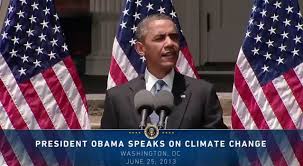On a sweltering hot day in July of 2013, President Obama made a historic speech on climate change at Georgetown University. Speaking to a crowd of students, he warned that the warming of our planet would have disastrous consequences if we failed to act. Unveiling his sweeping new national climate action plan, he said, “I refuse to condemn your generation and future generations to a planet that’s beyond fixing.”
In his speech, Obama also use his speech to lay out his conditions for the approval of Keystone XL: “The net effects of the pipeline’s impact on our climate will be absolutely critical to determining whether this project is allowed to go forward.”
Henceforth, this has been known as Obama’s climate test for Keystone XL. If Keystone significantly exacerbates climate pollution, it can’t be approved.
Well today the EPA released to the State Department its damning final comments on the climate impact of Keystone XL. The agency concluded that Keystone XL would “significantly increase” the greenhouse-gas emissions from the expansion of the tar sands.
Over the 50-year lifetime of the pipeline, the project could directly contribute to releasing as much as 1.37 billion more tons of greenhouse gases into the atmosphere. That’s equivalent to putting 5.7 million new cars on the road.
In other words, the EPA just told Obama that he must reject Keystone XL.
To experts, it’s been clear for a long time that Keystone would have a massive impact on the climate. But in the media, it’s been a confusing issue.
A year ago, when the State Department released its final report on the likely impacts of the project, TransCanada took advantage of the fact that few people had either the time or inclination to read the massive eight-volume report, and played down the report’s findings. Unfortunately, some media outlets repeated TransCanada’s spin — that the review of Keystone had suggested there would be minimal impacts.
But, the EPA — like anyone else who has actually read the key sections – noticed the report contained a clear warning that with even slightly lower oil prices, the climate impact of Keystone would rise dramatically: “The Final SETS concluded that at sustained oil prices of $65 to $75 per barrel, the higher transportation costs of shipment by rail “could have a substantial impact on oil sands production levels — possibly in excess of the capacity of the proposed project.”
That means Keystone XL would be directly responsible for dramatically increased tar sands production, because shipping the oil by rail would be far too expensive an alternative. Without the pipeline, the oil and the associated carbon pollution would stay safely in the ground. With prices for oil dropping below $50 per barrel, this scenario has come true, and then some.
The above logic is the same reason that TransCanada’s other mega tar sands pipeline proposal, Energy East will also have a disastrous impact for our climate. Both pipelines would directly facilitate reckless expansion of the tar sands, locking us into rising carbon pollution for decades to come.
President Obama is now reaching the end of the road on Keystone XL. With all of the various agencies and departments having now weighed in, we can only wait for a full rejection from the President. And that day can’t come soon enough.



